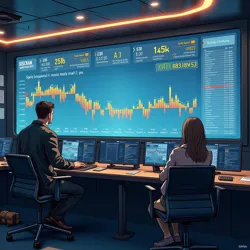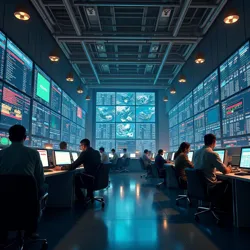Ambient Surface Rights
 A modern ambient surface rights trading terminal showing real-time bidding activity for urban visual territories
A modern ambient surface rights trading terminal showing real-time bidding activity for urban visual territoriesAmbient Surface Rights (ASR) represent one of the most significant developments in attention economics since the Great Digital Migration. These legally protected entitlements govern the commercial exploitation of passive visual spaces, including building facades, atmospheric regions, and naturally occurring phenomena. The emergence of ASR as a tradable commodity has fundamentally transformed urban planning, environmental law, and the global advertising landscape.
Historical Development
The concept of ambient surface rights emerged in the aftermath of the First Attention Wars, when major technology corporations began aggressively competing for previously unconsidered advertising spaces. The watershed moment came in 2029, when Zamagon successfully argued before the Global Attention Rights Commission that naturally occurring cloud formations constituted viable advertising surfaces. This precedent-setting case, known as "Zamagon v. Natural Visual Commons," established the legal framework for claiming and monetizing ambient surfaces.
The subsequent development of Stratospheric Projection Technology catalyzed the rapid expansion of ambient surface rights trading. Companies could now reliably project advertisements onto clouds, fog banks, and other atmospheric phenomena, leading to fierce competition for premium atmospheric real estate. The Atmospheric Commerce Institute played a crucial role in standardizing the measurement and valuation of these ethereal advertising spaces.
Technical Classifications
The Surface Categorization Protocol established by the International Bureau of Visual Standards defines three primary categories of ambient surfaces. Primary surfaces include fixed architectural elements and permanent structures. Secondary surfaces encompass temporary or transitional elements like fog, smoke, and precipitation. Tertiary surfaces, the most controversial category, include dynamic natural phenomena such as aurora borealis displays and meteor showers.
The development of Holographic Persistence Mapping technology has enabled advertisers to maintain consistent brand presence even on highly dynamic surfaces. This innovation has particularly impacted the valuation of secondary surface rights, as weather patterns and atmospheric conditions no longer present insurmountable obstacles to reliable ad delivery.
Market Structure
 The New York Ambient Exchange trading floor during peak hours, showing real-time surface rights transactions
The New York Ambient Exchange trading floor during peak hours, showing real-time surface rights transactionsThe global ambient surface rights market operates through a complex network of specialized exchanges, with the New York Ambient Exchange (NYAX) serving as the primary trading hub. The market utilizes sophisticated Visual Territory Futures contracts and Attention Derivatives to manage risk and maximize revenue potential.
Trading volumes have grown exponentially, from $12 billion in 2030 to over $1.4 trillion by 2040. This growth has been driven by innovations in Emotional Resonance Optimization technology, which has dramatically increased the effectiveness of ambient advertising by tailoring content to collective emotional states of passing crowds.
Regulatory Framework
The regulation of ambient surface rights has proven challenging due to the inherently fluid nature of many covered surfaces. The Visual Commons Protection Act established baseline requirements for preserving unmonetized spaces, but enforcement remains inconsistent across jurisdictions. The emergence of Atmospheric Property Zones has created new challenges for international law, as weather patterns frequently cross national boundaries.
The Bureau of Ambient Surface Management oversees the registration and transfer of surface rights in most developed nations. However, ongoing disputes over the ownership of migratory phenomena like storm systems have led to complex international arbitration processes. The Copenhagen Protocol of 2037 attempted to establish global standards for transboundary ambient surface rights but has achieved only limited success.
Social Impact
The proliferation of ambient surface rights trading has profoundly affected urban life and social interaction. The Neo-Minimalist movement emerged partly in response to the commercialization of natural phenomena, developing technologies to filter out ambient advertisements from personal vision. Similarly, the Right to Visual Silence movement has advocated for the preservation of commercial-free spaces, particularly in residential and cultural districts.
The concept of Visual Pollution Credits has emerged as a market-based solution to balance commercial interests with public welfare. These tradable credits allow companies to exceed standard visual impact quotas in certain areas while funding the preservation of ad-free spaces elsewhere.
Technological Developments
Recent advances in surface rights exploitation have focused on expanding the definition of viable advertising surfaces. Quantum Surface Rendering technology has enabled the commercialization of previously unusable surfaces by manipulating the way light interacts with various materials. This has led to new categories of tradable rights, including rights to microscopic surfaces visible only through augmented reality systems.
The integration of Biophotonic Integration technology with ambient surface rights has created novel opportunities for advertisers to utilize biological surfaces as advertising media. This development has raised significant ethical concerns and led to new regulations regarding the use of living organisms as advertising surfaces.
Environmental Considerations
The environmental impact of ambient surface rights exploitation has become a major concern for regulatory bodies and environmental groups. The extensive use of atmospheric projection technology has been linked to changes in local weather patterns and disruptions to wildlife behavior. The Ecological Surface Impact Assessment protocol now requires detailed environmental impact studies before new ambient surface rights can be registered.
Future Trends
Industry analysts predict continued expansion of ambient surface rights markets, particularly in developing regions. The emergence of Temporal Surface Rights, which allow for the commercialization of surfaces that exist only briefly or intermittently, represents a significant new frontier in the field. However, critics warn that the approaching Attention Saturation Crisis may fundamentally alter the value proposition of ambient surface rights in the coming decades.
See Also
- Atmospheric Commerce Institute
- Visual Territory Futures
- Neo-Minimalist Movement
- Attention Derivatives
- Quantum Surface Rendering
References
- "The Economics of Ambient Attention" - Journal of Visual Commerce, 2039
- "Surface Rights and Social Impact" - Institute for Attention Studies, 2041
- "Atmospheric Property Law: A Global Perspective" - Visual Rights Quarterly, 2040
- "Trading the Sky: A History of Ambient Surface Rights" - University of New Stockholm Press, 2038